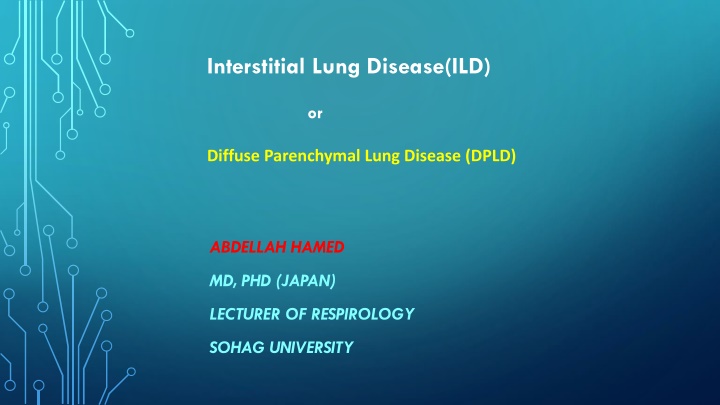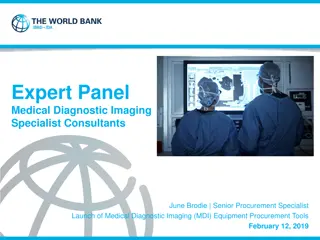
Understanding Interstitial Lung Disease (ILD) and DPLD: A Comprehensive Overview
Learn about Interstitial Lung Disease (ILD) and Diffuse Parenchymal Lung Disease (DPLD) including their introduction, classification, epidemiology, pathogenesis, clinical features, investigation, and treatment. Explore the history, terminology, and classification of ILD/DPLD, along with clinical subtypes such as Idiopathic IPF, Occupational, Connective Tissue Diseases, Sarcoidosis, and Drug-induced cases.
Download Presentation

Please find below an Image/Link to download the presentation.
The content on the website is provided AS IS for your information and personal use only. It may not be sold, licensed, or shared on other websites without obtaining consent from the author. If you encounter any issues during the download, it is possible that the publisher has removed the file from their server.
You are allowed to download the files provided on this website for personal or commercial use, subject to the condition that they are used lawfully. All files are the property of their respective owners.
The content on the website is provided AS IS for your information and personal use only. It may not be sold, licensed, or shared on other websites without obtaining consent from the author.
E N D
Presentation Transcript
Interstitial Lung Disease(ILD) or Diffuse Parenchymal Lung Disease (DPLD) ABDELLAH HAMED MD, PHD (JAPAN) LECTURER OF RESPIROLOGY SOHAG UNIVERSITY
OUTLINE Introduction Classification Epidemiology Pathogenesis Clinical features Investigation Treatment
INTRODUCTION Interstitial Lung Disease refers to a broad range of conditions that have common clinical, physiological, and radiological features. ILD is not one disease but several diseases that do not necessarily share a common histopathological or pathophysiological basis
HAMMAN and RICH were the first to describe (in 1935 and 1944) four patients who died of rapidly progressive lung disease characterized by diffuse interstitial pneumonia and fibrosis. Interstitium Refers to the microscopic anatomic space bounded by the basement membrane of epithelial and endothelial cells. Within this interstitial space, fibroblast like cells (mesenchymal and connective tissue cells) and extracellular matrix components (interstitial collagens, elastin, proteoglycans) are present
INTRODUCTION By strict definition Interstitial lung disease involves abnormalities of the interstitium the potential space between the epithelium and capillary endothelial basement membrane within the alveolus . HOWEVER ..
INTRODUCTION Interstitial is a misleading terminology because most of these disorders are associated with extensive alteration of airway and alveolar architecture in addition to changes in interstitial compartment. For this reason Diffuse Parenchymal Lung Disease or DPLD is the better term.
CLASSIFICATION OF DPLD DPLD : Two large groups (1)Idiopathic DPLD ( no known cause ) (2)Secondary to other diseases
CLINICAL CLASSIFICATION Idiopathic IPF Occupational Connective Tissue Diseases Sarcoidosis Drug induced
IDIOPATHIC Acute interstitial pneumonitis (Hamman-Rich syndrome) Usual Interstitial pneumonitis Desquamative interstitial pneumonitis Respiratory bronchiolitis Cryptogenic organizing pneumonia Nonspecific interstitial pneumonitis Lymphocytic interstitial pneumonia
CTD Scleroderma Polymyositis-dermatomyositis Systemic lupus erythematosus Rheumatoid arthritis** Mixed connective tissue disease Ankylosing spondylitis Behcet s Sjogren s syndrome
INORGANIC DUSTS Silica Asbestos Aluminum Coal dust. Beryllium. Mixed dusts Hard metal : Titanium oxide, tungsten cadmium.
ORGANIC DUSTS : HYPERSENSITIVITY PNEUMONITIS Farmer lung Bagassosis Humidifier lung, air cond. Bird breeder s lung
Drugs Chemotherapy : bleomycin, cyclophosphamide, methotrexate, procarbazine. Antiarrhythmic agents Amiodarone (Cordarone) is an antiarrhythmic medication used to treat ventricular tachycardia or ventricular fibrillation Anti-epileptic drugs Valproic acid ( Depakine). Radiotherapy
EPIDEMIOLOGY Incidence ranges from 3-26/1,00,000 per year. Prevalence of preclinical and undiagnosed ILD is estimated to be 10 times that of clinical recognized disease. IPF is the most common form representing at least 30 percent of the incident cases.
PATHOGENESIS Epithelial cell apoptosis with loss of basement membrane integrity: production of growth factors in response to alveolar epithelial injury with hyperplastic type II cells and myofibroblast recruitment
DIAGNOSIS Diagnosis Biopsy FOB PFT HRCT CXR Examination History
APPROACH TO THE DIAGNOSIS OF ILD Clinical Pathology History Physical Laboratory PFTs Surgical lung biopsy Radiology Chest X-ray HRCT
RESPIRATORY SYMPTOMS Breathlessness (most common): Initially, dyspnea on exertion later at rest Nonproductive cough Pleuritic chest pain Wheeing Hemoptysis
NON RESPIRATORY SYMPTOMS Arthritis Ocular Skin and muscle GERD Lower GI symptoms Recurrent sinusitis Neurological symptoms Epilepsy & mental retardation Diabetes inspidus
ONSET OF SYMPTOMS 1. Acute presentation (days to weeks)- eg: Acute idiopathic interstitial pneumoni,Hypersensitive pneumonitis 2. Sub-acute presentation (weeks to months)- eg: Sarcoidosis,Drug induced ILD ,Alveolar hemorrhage syndromes 3. Chronic presentation (months to years) eg: IPF
ILD-HISTORY Smoking Medication history- Amiodorane, Methotrexate, Occupational history Environmental exposure history
OCCUPATIONAL HISTORY ? Pneumoconioses miners ? Silicosis sand blasters & granite workers ? Asbestosis welders, electricians, mechanics, workers with brakes, shipyard workers ? Berylliosis aerospace, nuclear, computer & electronic industries ? Hypersensitive pneumonitis farm workers, poultry workers, bird breeders ? The degree of exposure, duration, latency of exposure, and the use of protective devices should be elicited
ENVIRONMENTAL EXPOSURE HISTORY ? ? ? ? ? Exposures to pets (especially birds) Air conditioners Humidifiers Hot tubs Evaporative cooling systems
ILD-SIGNS Crackles - Dry, velcro , end inspiratory, predominantly bibasilar Inspiratory squeaks- Mid inspiratory wheez, high pitched- Seen in Small Airway pathologies Cor pulmonale features Clubbing IPF Cyanosis
EXTRA PULMONARY -SIGNS Skin abnormalities Lymphadenopathy Hepatosplenomegaly Maculopapular skin rashes Erythema nodosum Subcutaneous nodules Proximal muscle weakness Arthritis
INVESTIGATIONS Laboratory studies: Complete blood count with differential, ESR. Renal & liver function tests. Serologic studies: should be obtained if clinically indicated by features suggestive of a connective tissue disease (Antinuclear antibodies, rheumatoid factor), environmental exposure (hypersensitivity precipitin panel), or systemic vasculitis (antineutrophil cytoplasmic antibodies, anti-glomerular basement membrane antibody). 30
Radiology: usually abnormal Chest x-ray: normal ~ 10%. High resolution CT scan chest Radiological pattern of disease Reticulo / Nodular. GGO Pleural involvement Honeycomb Interlobar septal thickening Hilar adenopathy Anatomical distribution(upper or lower zone) 31
CHEST X RAY Typically small lung volumes with Reticular , Nodular, or RETICULONODULAR shadow
HIGH-RESOLUTION COMPUTED TOPOGRAPHY (HRCT) HRCT is more sensitive Combinations of ground glass changes, reticulonodular shadowing, honeycomb cysts and traction bronchiectasis
PULMONARY FUNCTION TESTING Restrictive pathology Grading the severity Monitoring the response to therapy
PULMONARY FUNCTION TESTING Restrictive Defect Lung volumes (TLC, FRC,RV <80%) FEV1, FVC With Normal or FEV1/FVC Reduced diffusing capacity (DLCO) ABG Type 1 RF
LUNG BIOPSY Open lung biopsy Transbronchial Not required to make the diagnosis in all patient with ILD. To reach a definitive diagnosis or to stage a disease without examination of lung tissue. Indication for lung biopsy: - to assess disease activity - to exclude neoplasm or infection - to establish a definitive Dx before starting a effects - treatment with serious side 37
MANEGEMENT PRINCIPAL AIMS: (1) to remove exposure to injurious agents (2) to suppress inflammation to prevent further destruction of the pulmonary parenchyma (3) to palliate the manifestations of these diseases.
CORTICOSTERIODS Prednisone, 1 mg/kg for 1 month Gradually tapered (5 mg/week) over several months to a maintenance dose 10 mg daily
IMMUNO SUPPRESSIVE AGENTS Cytotoxic agents (Azathioprine) may be used in patients who do not improve on steroid therapy or who cannot tolerate corticosteroids agents (Cyclophosphamide)or immunosuppressive
N-ACETYL CYSTEIN Antioxidant 600 mg PO tid added to prednisone and azathioprine, preserves vital capacity and FVC and DLCO
New DRUGS PIRFENIDONE Antifibrotic Reduces acute exacerbations and reduction in FVC Imatinib mesylate (A protein-tyrosine kinase inhibitor).
OXYGEN THERAPY For patients with documented hypoxia SpO2<89% , PaO2<55m m H g Improves exercise tolerance
LUNG TRANSPLANTATION Failure of medical treatment . Single lung transplantation is currently the preferred surgical operation.
COMPLICATIONS Progressive respiratory failure Pneumonia Cor pulmonale Pneumothorax Bronchial carcinoma Pulmonary embolism Drug toxicity
WORSE PROGNOSIS Old age Male Smoking Honeycombing Lower DLCO < 40% Higher rate of acute exacerbations Pulmonary HT



